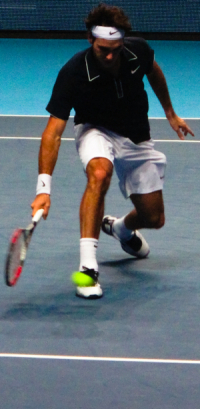Tennis YEC: Swiss Better than Round-Robin?
.The 2009 ATP year-end championships have finished the first, round-robin, stage, where the field of eight is split into two groups of four, and each group plays round-robin to winnow it down to the two who go to the single-elimination rounds (semifinals and final). There have been some interesting effects of running the tournament this way, and I wonder whether a different setup would be superior.

Photograph by adambowie
Most major tennis tournaments have significantly larger numbers of competitors. The YEC is for the top eight players that year, so is a kind of invitational. It’s generally considered less important than a Grand Slam event but more important than anything else other than the Olympics, and is also meant as a showcase of tennis. “Showcase” here means a tournament which is only composed of top (and hence well-known) players, and in which at least some interesting matches are guaranteed (unlike single-elimination tourmanents, where upsets can mean that well-known players never face each other). Round-robin play ensures predictable scheduling, which makes ticket sales easier, as the organizers can for example say that Roger Federer will be playing in three matches in the first week.
This year’s groups were set up as follows:
| Group A | Group B |
|
|
One of the major problems with round-robin is that results may be too even—in a four-person group, it’s possible for three players to end up at two–one, with one player at zero–three.
This is exactly what happened this year, in both groups. This meant that tiebreaking statistics had to be used to eliminate two players with winning records (one from each group). The tiebreakers used are set win percentage and game win percentage.
I consider both of these highly problematic for tennis, but particularly the latter. I can see an argument for a three-set match being a very different matter than a two-set match, but I cannot see any good tennis reason to distinguish between losing a set 3–6 and losing a set 4–6. Part of the beauty of the tennis scoring system is that the only increment that matters is the last one, the one that gets you the win.
On Thursday Federer, who won his first two matches, played Del Potro, who was one–one. Andy Murray had already played his matches and was two–one. If Federer won, Murray would go through and Del Potro would be out. However, if Federer lost, matters were more complicated, as all three players would be at two–one. If Federer lost in straight sets, he would be out and the others would go through.
Del Potro won the first set and was up 5–4 on serve in the tiebreak in the second, meaning that both Del Potro and Murray were two points from the semifinals.
Federer took the next three points and the set. Now, he was almost guaranteed to go through, but if he lost the set, the score in games would determine whether Del Potro or Murray would go through. It transpired that if Federer won more than three games in the set, Murray would be out.
Federer had two break points on Del Potro’s serve at 3–3—meaning really that he had two points to eliminate Del Potro and put Murray through. He couldn’t get the break. And serving at 3–4, Federer had a serious lapse in concentration, and his previously solid serving disappeared. Del Potro won that game at love, and then served out the match—thus eliminating not Federer but Murray.
I appreciate the drama, but Murray’s fate hinging on a single point that might not even have decided the set, in a match he wasn’t playing, is rather ridiculous.
The benefits of round-robin are that matches are guaranteed to occur, and players can play their way into form rather than having to worry about a bad first day putting them out. Disadvantages include the above, and the fact that there are scenarios in which certain games can be pointless—if Federer and Del Potro had both gone into that match 2–0, there wouldn’t have been a tremendous amount of motivation for them in it.
That being the case, I don’t see why the organizers don’t replace the round-robin with Swiss instead. Same number of matches, a cut to top four, and the same guarantee that all the players will stick around for at least three matches. There will be “dead” matches after two rounds, as the winless and undefeated players won’t have much to play for in their third match (although the latter might be motivated to play for seeding at the semifinal stage), but the other will all be playing hard, and there’s no need for nonsense with set win percentage and game win percentage—draws are impossible in tennis, and so a single three–zero player and three two–one players would emerge every time.
Furthermore, with no need to divide the players into separate groups, there’s no worry that the groups might be unbalanced. The first round could be seeded, if desired. Each player would still play three times. The only disadvantage that I can think of is that it’s possible that some of the “interesting” matches might not happen—e.g. if you really want Federer–Nadal, and one of them wins their first match while the other loses, they can only then meet in the semifinals or finals. But that can happen with random groups in round-robin anyway.
Given how much more sense it makes competitively, and that it has many of the same advantages for the organizers, I’m not sure why they’re not using Swiss for this tournament.